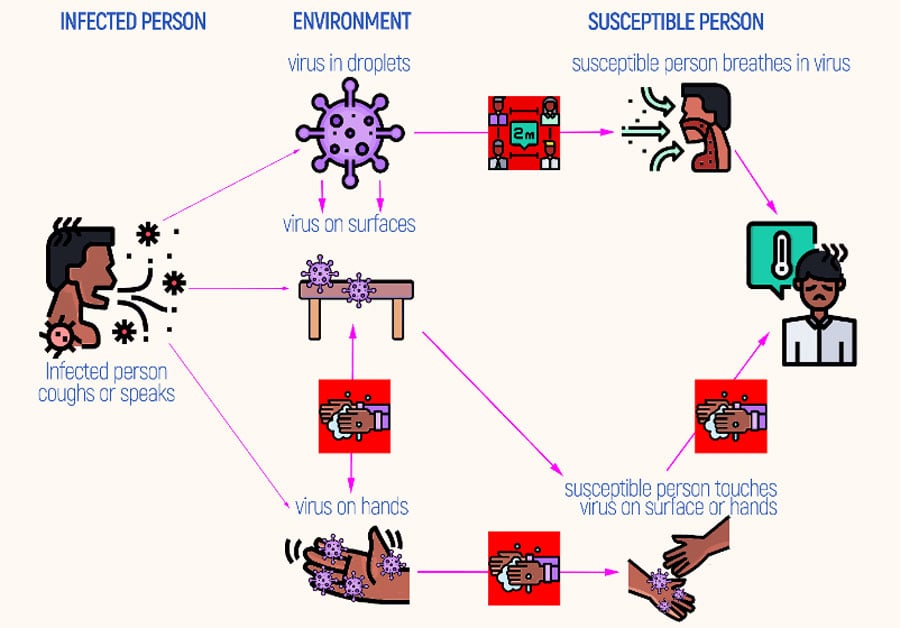How to set up government-led national hygiene communication campaigns to combat COVID-19: a strategic blueprint
London School of Hygiene & Tropical Medicine https://lshtm.ac.uk/themes/custom/lshtm/images/lshtm-logo-black.png Thursday 18 June 2020Whether it’s hand hygiene, physical distancing, disinfecting surfaces, wearing masks or taking actions to protect the most vulnerable, behavior change has a key role to play in tackling the COVID-19 (coronavirus) pandemic. That’s why a new brief from the World Bank, London School of Hygiene & Tropical Medicine, Harvard Kennedy School and Project Clear provides guidelines and principles to help governments develop national behavior change communications strategies.
The brief draws from academic literature, recent research, analysis of existing initiatives and examples from projects across the world to offer ten essential components for rapidly developing a communications strategy to combat COVID-19.
- Step 1 - Set up a communications task force. An agile and action-oriented task force, headed up by a national focal point, is needed to execute the strategy and should include representatives from the Ministry of Health, the private sector, media, behavioral scientists, and creative and communications specialists.
- Step 2 - Mobilize resources, including from the private sector. Core government funding for COVID communications needs to be mobilized rapidly and can be complemented with help from donors and from the private sector, who have many relevant skills to offer.
- Step 3 - Define which behaviors need to change and by whom. Campaigns need to be specific and clear about what behavior they want people to adopt. Hand hygiene and physical distancing are key to interrupting COVID-19 transmission in the community, as shown below.
- Step 4 - Review what is being done internationally and locally. Country programmes need to be aware of global developments, gathered from authoritative sources including WHO, Compass, World Bank and Hygiene Hub. The task force also needs to map all existing national efforts, as well as quickly countering misinformation.
- Step 5 - Review what is known about the drivers of risk behaviors and rapidly fill in knowledge gaps. An effective national plan needs to engage the population with messages that are new and surprising in order to grab people’s attention. The communications must motivate action by making the behavior something that people will want to do. Above all, the advocated behavior has to be possible. Rapid in-depth research into what people are doing and why, especially in vulnerable or marginalized groups, is vital.
- Step 6 - Produce a creative brief and theory of change. A creative brief is the guiding document that sets out the problem, purpose, objectives, target behaviors, audience characterization, channels of communication, persuasive argument, tone, personality, measures of impact and the materials required from the creative team.
- Step 7 - Develop a unifying national brand. Governments need to brand their national campaigns to help establish trust and credibility and ensure coherence. The logo should be based on existing government brands but have new, eye-catching elements, while the slogan should encapsulate the primary insight of the campaign.
- Step 8 - Develop executions employing the most relevant channels for the target audiences. Content may take the form of TV and radio commercials, or of ‘memes’ for social media, or of content for existing TV and radio shows to generate discussion and social media sharing – for messaging to go viral, it must be worth sharing.
- Step 9 - Rapidly pre-test and continually revise materials. In emergency conditions, some pre-testing, for example through phone calls with small samples of target audiences, is possible – allowing course corrections before materials are released. Content will need to be revised and refreshed often, as the impact diminishes as surprise fades and circumstances evolve.
- Step 10 - Monitor, evaluate, and share lessons. Continual monitoring of the effect of communications on behavior and behavioral indicators is essential, even if the circumstances of a pandemic offer particular challenges.
The current pandemic has focused attention on the vital importance of behavior change. However, behavior change is not just a matter of providing information, it requires strategies to ensure that people pay attention, and that they want to, and can, change their behavior. To achieve this, behavior change communications have to be surprising, cause revaluation of the behavior so that individuals will be motivated to act, and performance of the behavior should be enabled.
Strategic planning is hard in a pandemic but is achievable, can be rapid and will pay off in terms of programme effectiveness. Following the above guidance can help governments to encourage citizens to choose improved behavior now and sustain it into the future.
Read the brief from the World Bank, London School of Hygiene & Tropical Medicine, Harvard Kennedy School and Project Clear.
LSHTM's short courses provide opportunities to study specialised topics across a broad range of public and global health fields. From AMR to vaccines, travel medicine to clinical trials, and modelling to malaria, refresh your skills and join one of our short courses today.
